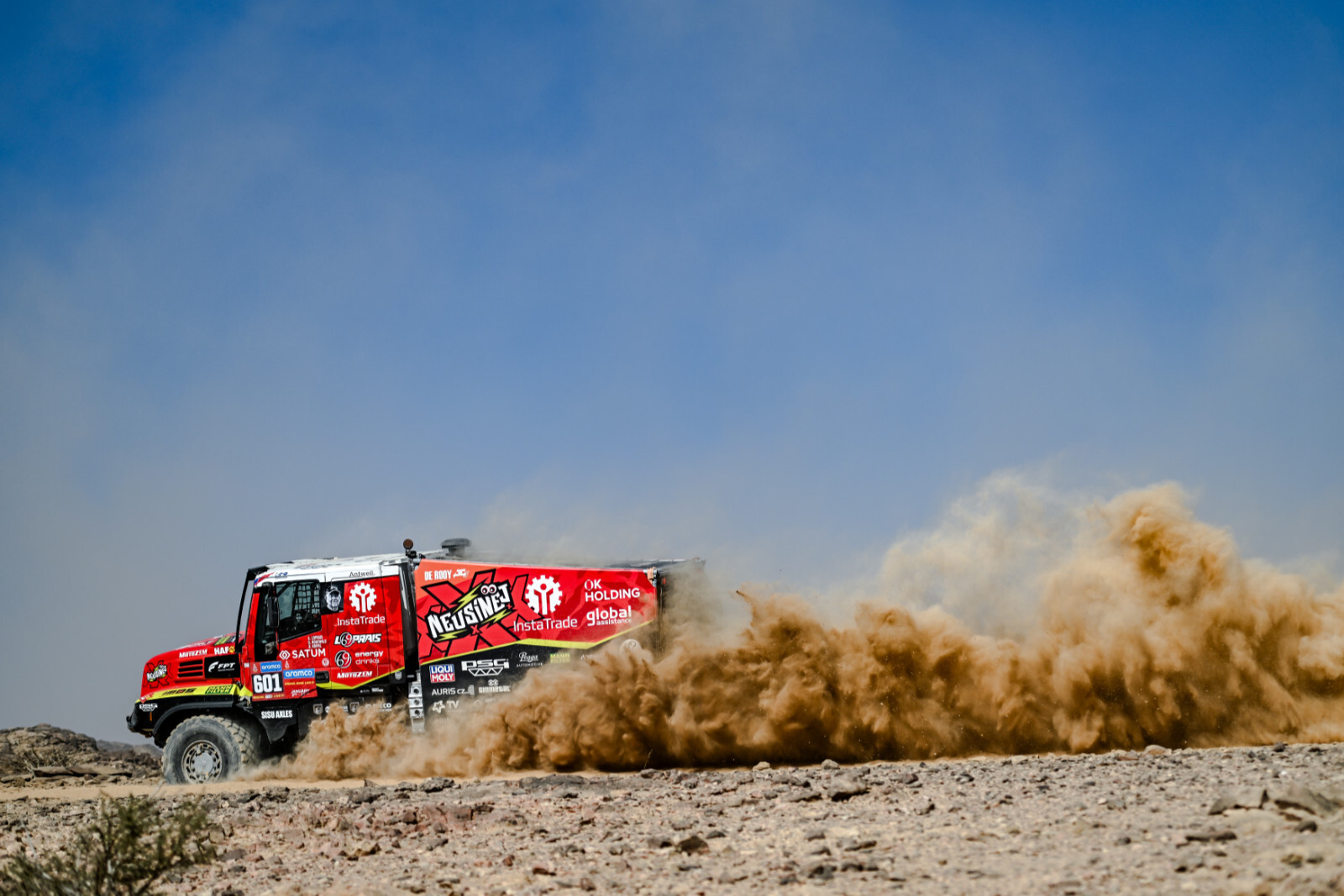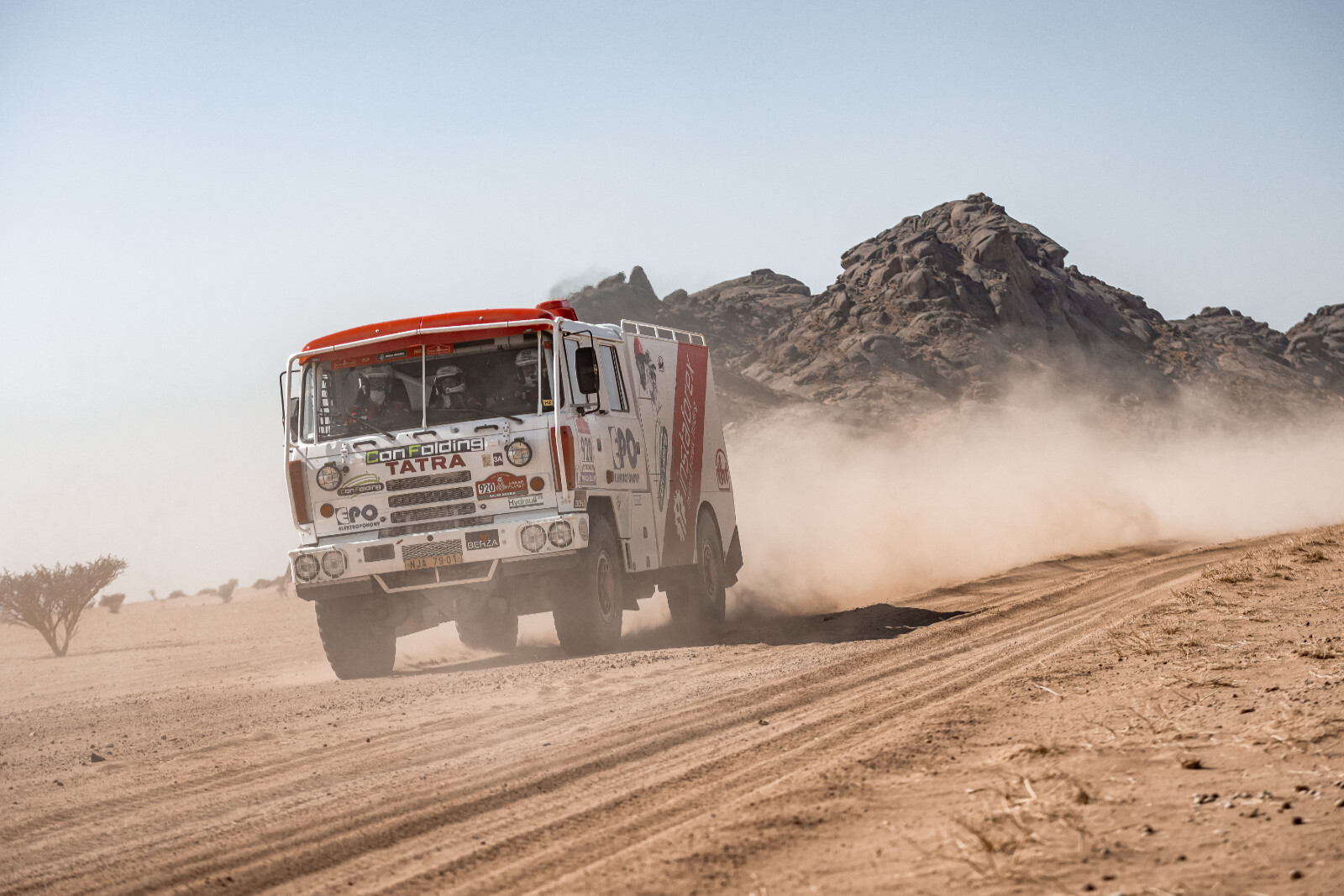The Dakar Rally 2025 continues to demonstrate why it’s considered one of the toughest motorsport challenges in the world. The second stage, a marathon stretching over a thousand kilometers, is a true test of endurance, skill, and strategy. Run over two days, this stage has already seen some of the top contenders falter, but the InstaSpot Loprais Team De Rooy FPT remains strong, asserting itself as a leading force in the truck category.
Ales Loprais, supported by teammates David Kripal and Darek Rodewald, began their marathon stage with exceptional precision and discipline. The trio spent the night of January 5th to 6th in the Break Zone at kilometer 546, deep in the Saudi Arabian wilderness. Known as the “48H Chrono Stage,” this section of the rally leaves competitors entirely self-reliant, without any assistance from team mechanics. It’s a battle of endurance not only against the terrain but also against the limitations of human and machine.
The Break Zone offered only the bare essentials: a tent, inflatable mattress, sleeping bag, drinking water, and basic food supplies for dinner and breakfast. Hot water was the only true luxury provided by the organizers. Missing were conveniences like showers or proper restroom facilities, emphasizing the rugged nature of this iconic rally.

The two-day stage, starting and finishing in Bisha, challenges competitors with 1058 kilometers of driving for trucks and cars, of which 967 kilometers are special stages. The diverse terrain includes fast gravel sections, rocky mountain paths, sand tracks, and dunes—some of which feature sharp, broken peaks that pose significant challenges even for the most experienced teams. The dunes, introduced on Sunday, represent just a taste of what awaits in the second half of this stage on Monday.
Competitors’ progress depended entirely on their skill and pace, as there were no fixed distances for the day. By 5 p.m. local time on January 5th, all teams were required to stop racing and rest at the nearest of six designated Break Zones along the route. This rule ensured fairness and safety, as well as a manageable schedule for teams to regroup and strategize for the next day.
Loprais and his crew, driving their distinctive red-and-black Iveco Powerstar #601, performed remarkably well on the first day. Throughout Sunday’s stage, they consistently stayed within the top three in the split times, showcasing both their driving expertise and the reliability of their vehicle. By the time they reached the Break Zone at kilometer 546, they had secured second place in the truck category, trailing only last year’s champion, Martin Macik, by a mere three minutes. Their performance highlighted not just their technical skill but also their ability to navigate the challenging terrain with precision and speed.
Only three other trucks managed to reach the same Break Zone before the time limit. Lithuanian driver Vaidotas Zala, piloting another Iveco prepared by Team De Rooy, arrived 24 minutes behind Loprais. Young Dutch talent Mitchel van den Brink also made it to the 546th kilometer in time. However, many others in the truck category had to stop earlier, with the previous bivouac at kilometer 521 serving as the final destination for the majority of the field.
The second day of this marathon stage began on January 6th, with 421 kilometers still remaining for the leading trucks to complete before reaching the finish line back in Bisha.

LOPRAIS TATRA TEAM & DAKAR CLASSIC
While the main Dakar categories pushed through their marathon stages, the Dakar Classic competitors faced their own challenges on January 5th and 6th. The classic vehicles, often older and less technologically advanced, provide a nostalgic glimpse into the rally’s storied history. After completing the first section of their marathon stage, the classic teams returned to the bivouac in Bisha. Here, they were allowed a strict 90-minute window to perform maintenance on their vehicles. Once this time elapsed, cars were secured in the Parc Ferme and could only be accessed again the following morning.
Sunday’s itinerary for the Dakar Classic included one navigation test and three regularity tests. Jiri Husek, Lubomír Dockal, and Dominik Holan, driving a restored Tatra 815 4×4 HAS, continued their strong form in the navigation test, completing it without any penalty points. This flawless performance kept them tied for first place in their category, underscoring their mastery of both navigation and vehicle control.
Meanwhile, the second Loprais Tatra Team entry, featuring Igor Pazdera, Olga Lounova, and Milan Holan in a replica Tatra 815-2 “Puma,” showed marked improvement in the regularity tests. Their results highlighted the team’s growing confidence and synchronization after a learning-intensive first day.
Navigator Olga Lounova shared insights into their progress: “The first stage was challenging as we adapted to navigating with a truck and familiarized ourselves with the new rules and equipment. Today, however, we felt more in control. While the navigation test had its moments of confusion, especially regarding points that weren’t always displayed on our screens, we managed to overcome these hurdles. Our results reflect that we’re starting to understand the system better.”.
For Lounova, who balances her roles as a racer and mother, the rally offers both challenges and rewards. “The biggest joy for me comes at the end of each day when I return to the hotel to see my daughter, Arianne,” she said of her two-year-old, who is accompanying her in Saudi Arabia. “I breastfeed at night and race during the day. It’s physically demanding, but it’s worth every moment. The crew’s support has been phenomenal, and I couldn’t ask for better teammates.”
The Dakar Classic marathon stage will conclude on January 6th, with participants tackling two more regularity tests and one navigation challenge. The final standings for this segment, as well as the overall rankings, will be released once all competitors have completed the stage.
As the Dakar Rally 2025 unfolds, the determination, skill, and endurance of the teams remain at the forefront, making it a spectacle of resilience and perseverance for fans and participants alike.









































